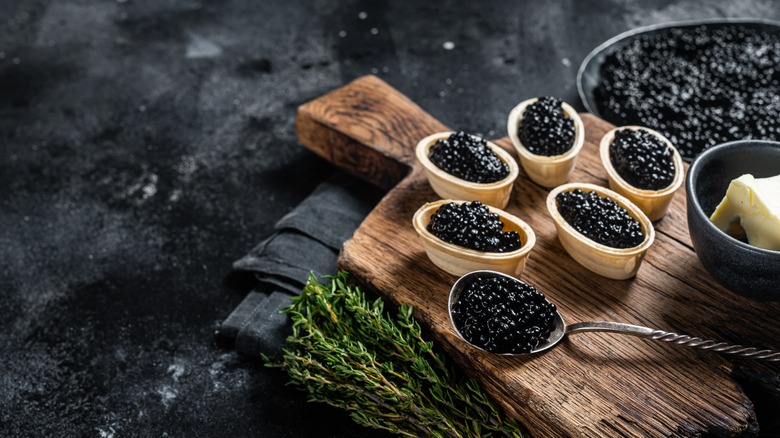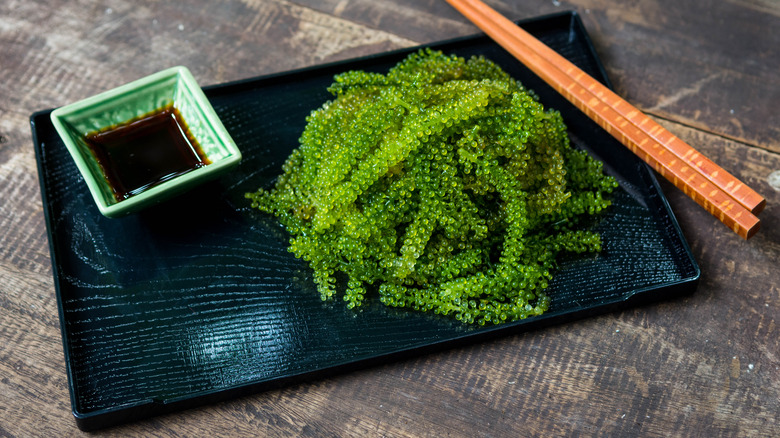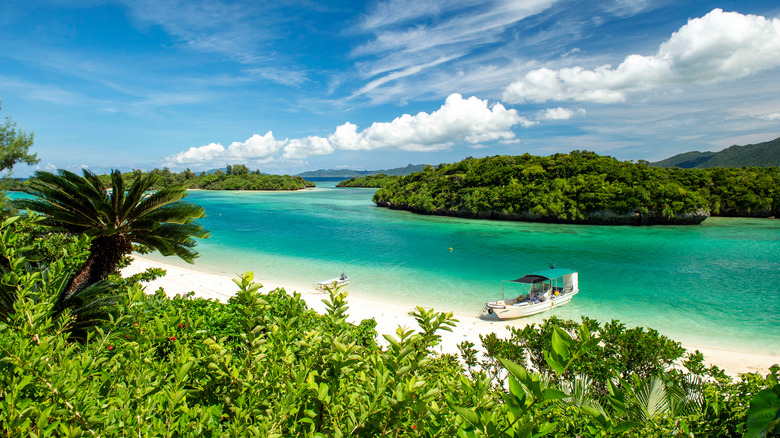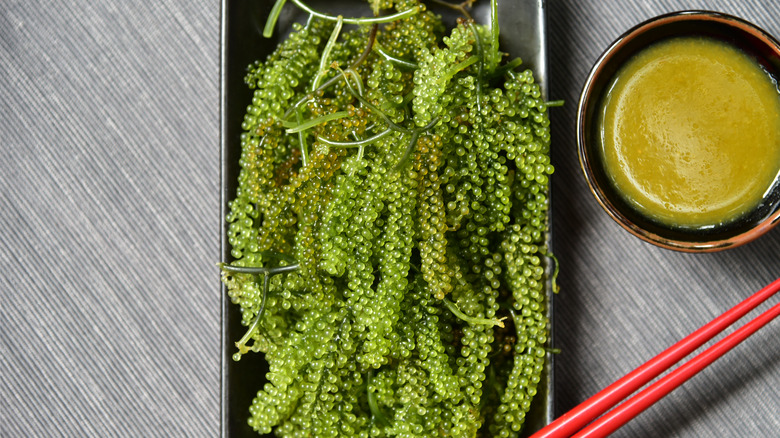The Sustainable Caviar Alternative That Happens To Be Vegan
A few decades ago, The Guardian recounts that the demand for caviar nearly sent beluga sturgeons into extinction. Fishermen would set sail to catch the fish, extract their eggs, and throw them back into the Caspian and Black seas to die, eventually driving the species into critical endangerment. Since the ban on trading wild sturgeons was enacted, many sturgeon aquafarms have made efforts to become more sustainable — but it still remains a big ethical question mark.
In 2022, the United Nations (UN) declared that the sustainable production of blue foods, the thousands of edible species of fish, plants, and algae, was essential for a stable and equitable global food supply, per Blue Foods Assessment. For many years, however, these foods were largely left out of the food system discussion — leading to what the UN Secretary-General António Guterres called an "ocean emergency." According to Los Angeles Times, many of the world's fish stocks are overfished, while aquaculture is polluting the ocean and spreading disease.
Despite its fancy price tag, caviar is not exempt. The carnivorous fish are often fed mackerel and sardines illegally sourced from the waters of West Africa and South Asia, per The Guardian, raising issues of food injustice. There's also the ethicality surrounding how the eggs are extracted; Even some sustainable sturgeon farms harvest them while the fish are still alive. Fortunately, there's another caviar-like delicacy that, according to Tsunagu Japan, has all the ocean flavor and freshness, with no moral dilemmas included: the seaweed known as umi-budō, or "sea grapes."
Taste and how it's eaten
Umi-budō has many names. Scientifically it's known as caulerpa lentillifera, and in Japanese, it's actually "kubiretsuta" (via Tsunagu Japan). Across Southeast Asia, Atlas Obscura defines cultures that have given the seaweed nicknames: In the Philippines, it's called "latô" or "arosep," and in Sabah, Malaysia, it's often referred to as "latok." But, umi-budō seems to be the one that has stuck. With the seaweed's bubbles that grow along its stems, the name translates to "sea grapes" and is the most descriptive of its reminiscence of a serving of tiny green grapes, per Japan Experience. However, it's been granted another name, "green caviar," that's both literal in the seaweed's resemblance to the fish eggs and suggestive of its use as a sustainable alternative.
Part of what makes umi-budō such a delicacy is its texture. As you bite into it, the bubbles pop in your mouth — a sensation that Japanese people call "puchi-puchi," per Japan Experience, in reference to the sound that the bubbles make when they burst. The experience is similar to caviar, according to Caviar Star. But, like other types of seaweed, umi-budō packs a fresh, briny, and ocean-like flavor in its tiny green pearls, per Japan Experience. Umi-budō is almost always eaten raw in order to preserve its special texture, as Tsunagu Japan explains. With it, the seaweed adds wonderful contrast and freshness to salads, sashimi, sushi, noodle dishes, and rice bowls (via Atlas Obscura). However, as Japan Experience notes, in Okinawa, Japan, where the umi-budō grows plentifully, it's traditionally served with soy sauce or vinegar and a cold beer.
Benefits
Along with it's many nicknames, Atlas Obscura claims that umi-budō is also notably known as the "longevity seaweed." In Okinawa, Japan, the seaweed is eaten regularly — and it's no coincidence that the island prefecture is also identified as one the world's five Blue Zones, the geographic areas where people live longer and healthier than anywhere else. While the BBC notes other correlating trends like the Okinawan's fulfilling social lives, and shared sense of "ikigai," or life purpose, the book "Ikigai: The Japanese Secret to a Long and Happy Life" points to their antioxidant and veggie-rich diets, which naturally includes the local specialty.
Not only is umi-budō an excellent source of plant-based protein, making it a great meat substitute that, as a blue food, contributes less greenhouse gas emissions than land-based livestock (via Blue Foods), but it's also full of vitamins and minerals. Umi-budō has become popular in the health-food industry thanks to its low calorie count and rich nutritional profile containing high amounts of fiber, minerals like iron, calcium, magnesium, and iodine, per Tsunagu Japan. It's also made particular waves among the beauty conscious, who link the seaweed's hyaluronic acid content to skin health.
Where it grows
According to Tsunagu Japan, the majority of umi-budō is harvested in Okinawa, Japan — the archipelago prefecture that divides the East China Sea and Philippine Sea, per Britannica. There, the temperature of the ocean water tends to hover around 77 degrees Fahrenheit, which is perfect for growing umi-budō, per Tsunagu Japan. Even though the delicacy is traditionally harvested from the ocean floor, Japan Experience explains that a combination of demand and climate change has made production more conducive to greenhouse farming. Most of this farming is centered in Miyako. There, just seven family farms grew umi-budō as of 2012. Since then, more farms have expanded into the main island — but they all face the same challenge.
Prior to greenhouse farming, umi-budō could only be harvested four months out of the year, per Japan Experience. While the greenhouses made the green caviar available year round, allowing farmers to meet the demand coming from the mainland, it didn't solve the issue of temperature. Coming from the tropical islands, umi-budō quickly goes bad if it gets too cold — and there aren't many delivery services that guarantee consistent warm conditions, especially when it comes to air transport.
With only a few days of freshness (under the right conditions) umi-budō is a food that's best enjoyed where it grows. If you look hard enough, you may find some restaurants and bars in mainland Japan that serve it. But, to truly experience umi-budō at it's finest, a trip to Okinawa is essential.
How to find it
If you're willing to travel the distance, Japan Experience says that in Okinawa, umi-budō is a natural part of the local food. There, you'll find it served as casually as bar nuts are in the U.S., or a serving of bread in France. Inside of an izakaya, Japan's informal drinking establishments (via Japan Guide), umi-budō is served the traditional way: Raw, with a side of with soy sauce or vinegar and a nice, refreshing cold beer. However, there are also restaurants where the delicacy is taken more seriously. In downtown Hirara, a city in Miyako where umi-budō farming is most abundant, explains Japan Experience, you can find restaurants like Ofukuro-tei that serve it on top of a bowl of rice, mixed with sashimi. According to Atlas Obscura, you can even find umi-budō-flavored ice cream in Okinawa.
While a trip to the tropical Japanese islands does sound dreamy, it's understandable if it's not included in any of your upcoming itineraries. While it undoubtedly is the best place to have umi-budō, Tsunagu Japan shares that online retailers like Amazon, Kenko Leaf Shop, and Nishikidor sell the seaweed. Just know that, due to it's short shelf life, the umi-budō will come dried and packaged in a salty seawater brine.




